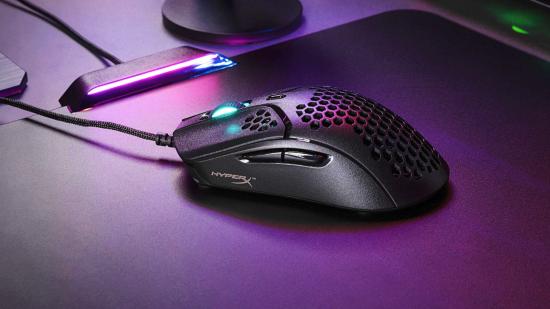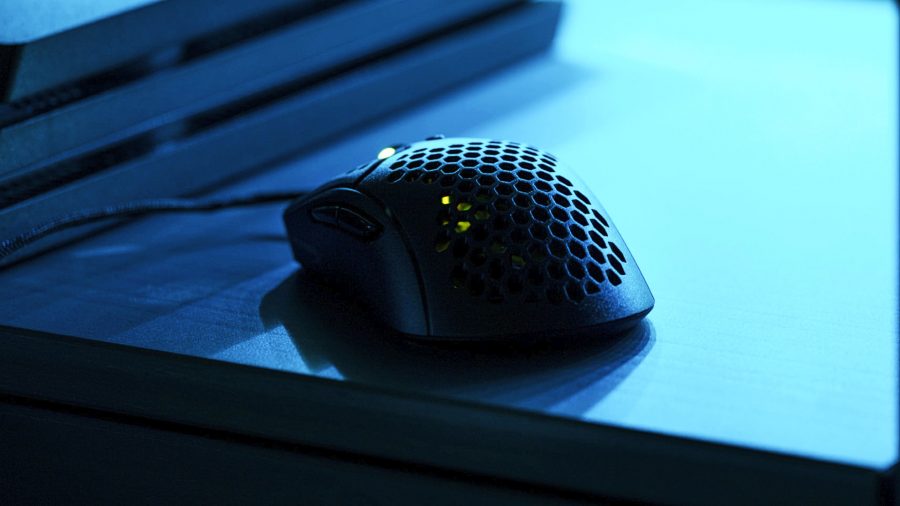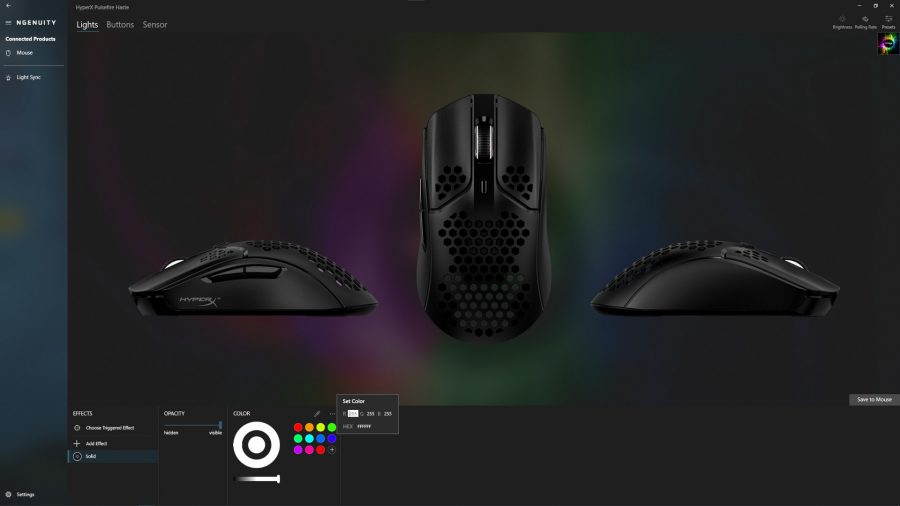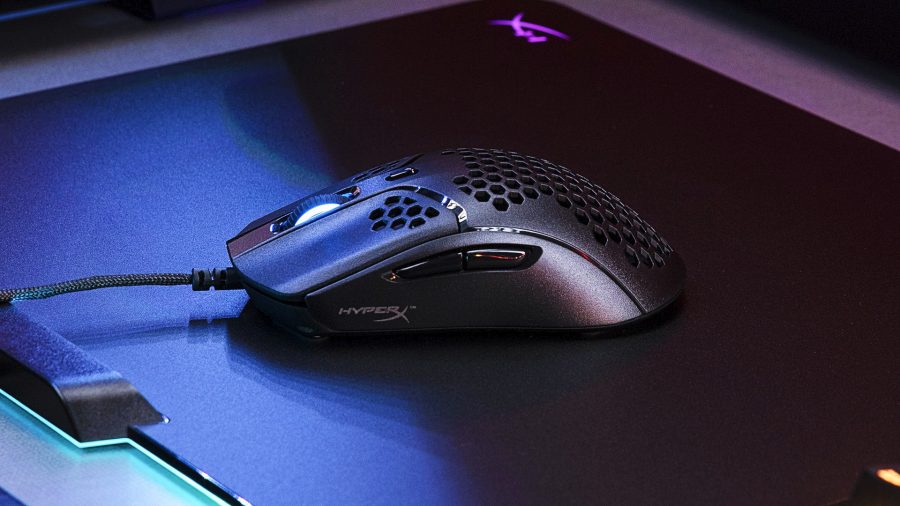Our Verdict
The best ultra-light gaming mouse bar none, that offers incredible value at $50
When I first laid eyes on the HyperX Pulsefire Haste, the hexagonal cutouts that extend from the base of its clickers down to its underside left me with a distinct feeling of unease. I don’t suffer from trypophobia or anything like that, but it just looked wrong. “Where’s the rest of it?” I joked to myself, but after having now used it for the past several weeks, I’ve grown rather fond of this lightweight rodent.
As you might’ve guessed, the hex shell design serves the purpose of trimming the HyperX Pulsefire Haste‘s weight down to just 59g, and is without a doubt the mouse’s hallmark feature. Swapping back and forth between my daily driver, the Corsair Sabre RGB Pro Wireless felt so much heavier and it only weighs 20g more at a meagre 79g of its own.
You might be worried that in order for HyperX to achieve this featherweight accolade, the company may have compromised the build quality or ergonomics of the Pulsefire Haste. I’m happy to report that this is absolutely not the case. Its matte plastic body and buttons feel sturdy to the touch, and I didn’t encounter any noticeable discomfort or trouble shifting between grip styles.
While the best gaming mouse can’t make you an esports professional overnight, I do feel like the HyperX Pulsefire Haste’s weight could benefit plenty of gamers out there. In my personal experience, I found the mouse to be the perfect instrument when performing quick turns in FPS games like Call of Duty: Warzone, and was well suited for the fast pace of team fights in League of Legends, without a trace of encumbrance.
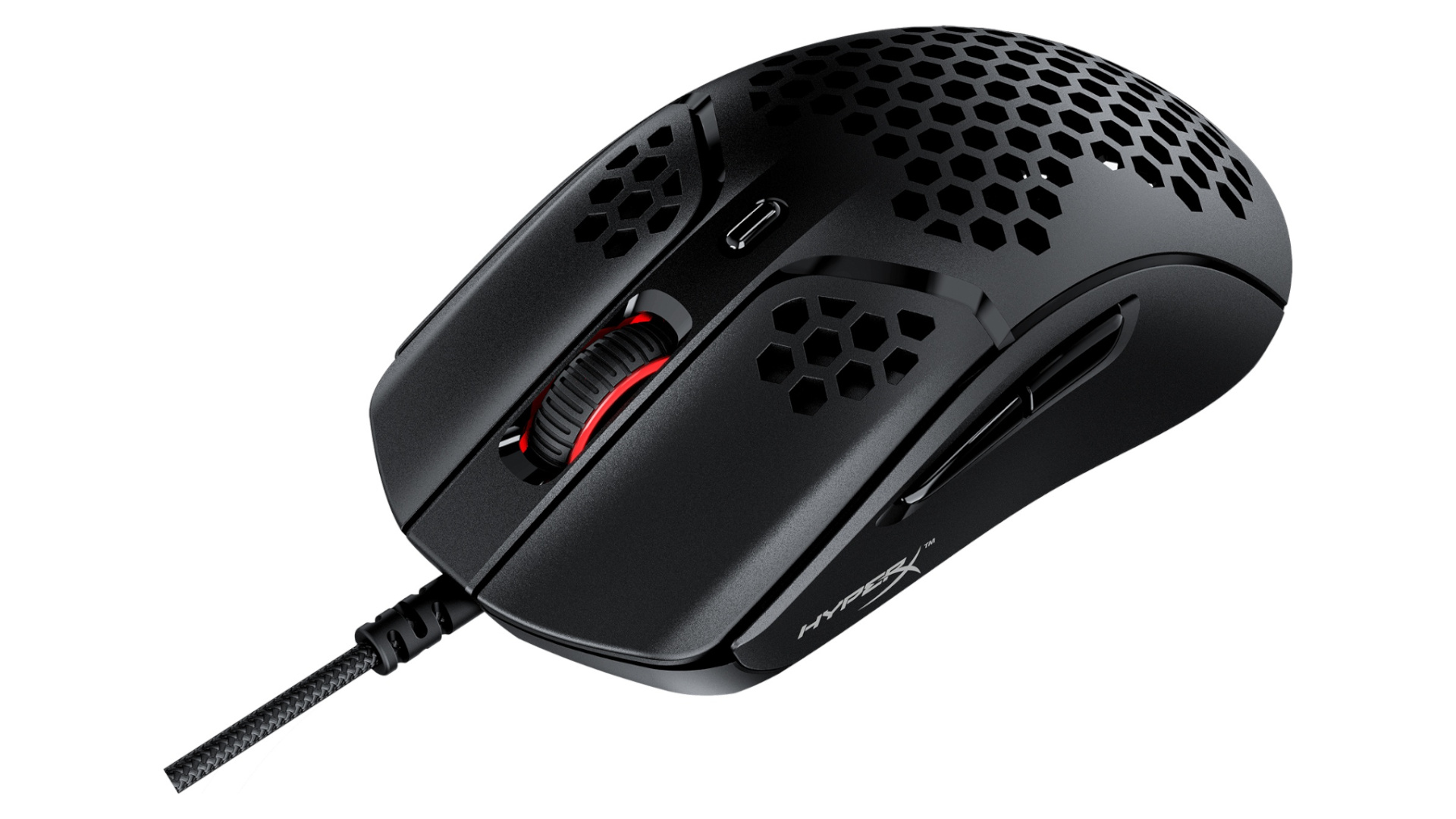 Check Prices
Check Prices
| HyperX Pulsefire Haste | SteelSeries Aerox 3 | Corsair Sabre Pro Champion Series | Razer Orochi V2 | |
|---|---|---|---|---|
| Sensor | Pixart PAW3335 | SteelSeries TrueMove Core | Pixart PMW3392 | Razer Optical |
| Max DPI | 16,000 | 8,500 | 18,000 | 18,000 |
| Programmable buttons | 6 | 6 | 6 | 6 |
| Lighting zones | 1 | 3 | 0 | 0 |
| Weight | 59g | 59g | 69g | 59g |
| Price | $50 | $60 | $55 | $70 |
Of course, weight is only part of the equation here. The HyperX Pulsefire Haste’s four ‘Pure virgin-grade’ PTFE skates gracefully glide across my cloth mouse mat, and the 21g braided HyperFlex USB-A cable keeps things snag free. While some form of cable tie to deal with any excess length would’ve been a nice touch, this is just me nitpicking at an otherwise faultless experience.
If it wasn’t already obvious, the HyperX Pulsefire Haste is an undeniably reliable and responsive rodent. The TT Golden Micro Dustproof switches underneath the mouse’s left and right buttons have a durability rating of 60 million clicks, meaning they’re built to last and should see you through the best PC games for many years to come. They’re programmable too, but I’ll touch on the software side of things a bit later.
The Pixart PAW3335 sensor makes for quite a pairing alongside the stalwart switches, capable of DPI resolutions up to 16,000. While this isn’t the highest you’ll find in the gaming mice market, it was plenty enough for my needs. In fact, my experience with the HyperX Pulsefire Haste has further instilled a belief in me that DPI becomes a moot spec at a certain point, and greater emphasis should be placed on weight, shape, and features instead.
Speaking of which, let’s talk about the HyperX NGenuity software. In my HyperX Pulsefire Dart review, I found the software suite to be unstable and unreliable, with it crashing and reporting false metrics on several occasions, so my expectations were low going into using it again. Thankfully, however, whether through updates or virtue of the HyperX Pulsefire Haste being a wired mouse, my experience this time around was decidedly more pleasant. No crashes. No bugs. Just how we like it.
In the NGenuity control panel, you can customise the HyperX Pulsefire Haste’s single lighting zone (found on the scroll wheel), as well as tinker with the mouse’s six programmable buttons and DPI presets. While it isn’t as robust as something like Razer Synapse or Corsair iCue, there’s definitely some value to be found in its less cluttered user interface.
It was easy to cycle through the admittedly limited lighting effects, with my personal favourite being ‘Fade’, which triggers whenever you click a button on the HyperX Pulsefire Haste. Whether you prefer a colour wheel, palette, or entering hex values, NGenuity’s got you covered. However, I do wish that some options weren’t hidden behind a menu, as there’s a lot of unused space that could be taken advantage of.
Of the six programmable buttons, only four are truly customisable with the left and right clicks being understandably limited to swapping between one another. I’ve never really been one to bother with these kinds of features, but found it simple enough to set up replacement functions, macros, or outright disable buttons.
While the HyperX Pulsefire Haste doesn’t come with every bell and whistle you’d find on some of its heavier and more expensive brethren, I still firmly believe that it’s the best lightweight mouse at this price point. For instance, despite the SteelSeries Aerox 3 also weighing 59g and offering more two more lighting zones, it’s $10 more expensive and can’t push past 8,500DPI. Meanwhile, the Razer Orochi V2 does have the advantage of wireless functionality and weighs in at the same value, but costs $20 more.
I understand that this mouse’s aesthetics may seem unattractive to some, but just as you wouldn’t judge a book by its cover, I urge you not to judge this mouse by its… holes. HyperX has crafted something special here. It’s a clicker that excels in every category that matters most, with a well-rounded but smartly trimmed set of tertiary features. As such, I really have no hesitation in crowning the HyperX Pulsefire Haste as the best ultra-light gaming mouse.
